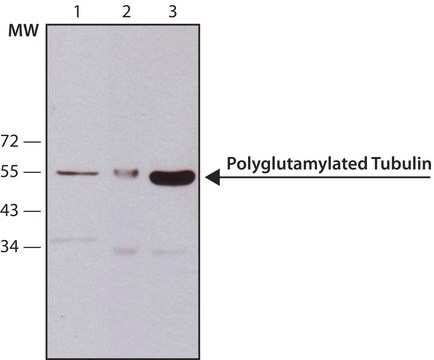AB15348
Anti-FMRFamide Antibody
serum, Chemicon®
Sinonimo/i:
Anti-Anti-FMRFAL
Autenticatiper visualizzare i prezzi riservati alla tua organizzazione & contrattuali
About This Item
Codice UNSPSC:
12352203
eCl@ss:
32160702
NACRES:
NA.41
Prodotti consigliati
Origine biologica
rabbit
Livello qualitativo
Forma dell’anticorpo
serum
Tipo di anticorpo
primary antibodies
Clone
polyclonal
Reattività contro le specie
rat
Produttore/marchio commerciale
Chemicon®
tecniche
immunohistochemistry: suitable
N° accesso NCBI
N° accesso UniProt
Condizioni di spedizione
dry ice
modifica post-traduzionali bersaglio
unmodified
Immunogeno
FMRFamide
Applicazioni
Anti-FMRFamide Antibody is an antibody against FMRFamide for use in IH.
Immunohistochemistry: 1:1,000 - 1:5,000
Application Notes for Immunohistochemistry:
- Suggested perfusion steps:
1) Ca2+-free Tyrode′s solution
2) Paraformaldehyde-picric acid fixative
3) 10% sucrose in PBS as a cryo-protectant
- Rapidly dissect tissue and store overnight in 0.1 M phosphate buffer (pH 7.4) containing 10% sucrose.
- Incubate slide-mounted tissue sections with blocking buffer for 1 hour at room temperature.
- Remove blocking buffer and incubate the slides with the primary antibody (AB15348 diluted to desired working concentration in blocking buffer) for 18-24 hours at 2-8°C.
- Remove primary antibody and rinse 3 times in PBS.
- Incubate sections with fluorescently labeled secondary antibody for 60 minutes at room temperature.
Optimal working dilutions must be determined by the end user.
Application Notes for Immunohistochemistry:
- Suggested perfusion steps:
1) Ca2+-free Tyrode′s solution
2) Paraformaldehyde-picric acid fixative
3) 10% sucrose in PBS as a cryo-protectant
- Rapidly dissect tissue and store overnight in 0.1 M phosphate buffer (pH 7.4) containing 10% sucrose.
- Incubate slide-mounted tissue sections with blocking buffer for 1 hour at room temperature.
- Remove blocking buffer and incubate the slides with the primary antibody (AB15348 diluted to desired working concentration in blocking buffer) for 18-24 hours at 2-8°C.
- Remove primary antibody and rinse 3 times in PBS.
- Incubate sections with fluorescently labeled secondary antibody for 60 minutes at room temperature.
Optimal working dilutions must be determined by the end user.
Research Category
Neuroscience
Neuroscience
Research Sub Category
Hormones & Receptors
Hormones & Receptors
Stato fisico
Liquid with 0.05% sodium azide.
Serum
Stoccaggio e stabilità
Maintain at -20°C in undiluted aliquots for up to 6 months after date of receipt. Avoid repeated freeze/thaw cycles.
Note legali
CHEMICON is a registered trademark of Merck KGaA, Darmstadt, Germany
Esclusione di responsabilità
Unless otherwise stated in our catalog or other company documentation accompanying the product(s), our products are intended for research use only and are not to be used for any other purpose, which includes but is not limited to, unauthorized commercial uses, in vitro diagnostic uses, ex vivo or in vivo therapeutic uses or any type of consumption or application to humans or animals.
Not finding the right product?
Try our Motore di ricerca dei prodotti.
Codice della classe di stoccaggio
10 - Combustible liquids
Classe di pericolosità dell'acqua (WGK)
WGK 1
Certificati d'analisi (COA)
Cerca il Certificati d'analisi (COA) digitando il numero di lotto/batch corrispondente. I numeri di lotto o di batch sono stampati sull'etichetta dei prodotti dopo la parola ‘Lotto’ o ‘Batch’.
Possiedi già questo prodotto?
I documenti relativi ai prodotti acquistati recentemente sono disponibili nell’Archivio dei documenti.
Yun Seon Bae et al.
Biology, 9(9) (2020-09-10)
Regeneration is a biological process restoring lost or amputated body parts. The capability of regeneration varies among organisms and the regeneration of the central nervous system (CNS) is limited to specific animals, including the earthworm Perionyx excavatus. Thus, it is
Ryan E Hulett et al.
Proceedings. Biological sciences, 287(1931), 20201198-20201198 (2020-07-23)
The origin of bilateral symmetry, a major transition in animal evolution, coincided with the evolution of organized nervous systems that show regionalization along major body axes. Studies of Xenacoelomorpha, the likely outgroup lineage to all other animals with bilateral symmetry
Tigran P Norekian et al.
The Journal of comparative neurology, 528(7), 1231-1254 (2019-11-22)
Cnidaria is the sister taxon to bilaterian animals, and therefore, represents a key reference lineage to understand early origins and evolution of the neural systems. The hydromedusa Aglantha digitale is arguably the best electrophysiologically studied jellyfish because of its system
Tigran P Norekian et al.
Frontiers in neuroscience, 17, 1125476-1125476 (2023-06-19)
Cilia are the major effectors in Ctenophores, but very little is known about their transmitter control and integration. Here, we present a simple protocol to monitor and quantify cilia activity and provide evidence for polysynaptic control of cilia coordination in
An Inhibitory Circuit From Brainstem to GnRH Neurons in Male Mice: A New Role for the RFRP Receptor.
Stephanie Constantin et al.
Endocrinology, 162(5) (2021-02-11)
RFamide-related peptides (RFRPs, mammalian orthologs of gonadotropin-inhibitory hormone) convey circadian, seasonal, and social cues to the reproductive system. They regulate gonadotropin secretion by modulating gonadotropin-releasing hormone (GnRH) neurons via the RFRP receptor. Mice lacking this receptor are fertile but exhibit
Il team dei nostri ricercatori vanta grande esperienza in tutte le aree della ricerca quali Life Science, scienza dei materiali, sintesi chimica, cromatografia, discipline analitiche, ecc..
Contatta l'Assistenza Tecnica.






![CHAPS (3-[(3-Cholamidopropyl)-dimethylammonio]-propane- sulfonate) for biochemistry](/deepweb/assets/sigmaaldrich/product/structures/265/550/452ffcaa-af89-4e31-99a1-0a0f29072b82/640/452ffcaa-af89-4e31-99a1-0a0f29072b82.png)
